Strawberry Wine Recipe: The Best Homemade Wine in the World
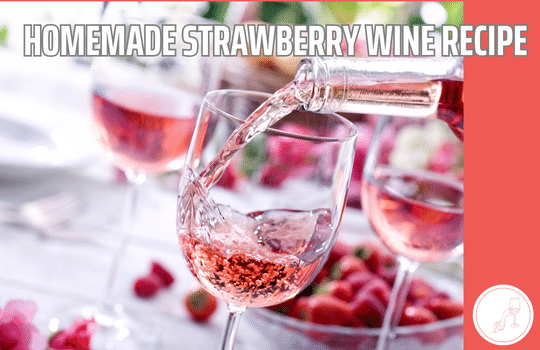
Done well, this strawberry wine recipe is probably the best homemade wine in the world.
But it is not exactly an easy wine to master… Strawberries are very high in fructose (sugar) and they leave a LOT of sediment behind once they’ve been fermenting for a while.
That means that you will need to keep a close eye on this mixture during the entire process, and it may take a little longer than other fruit wines due to the repetitive straining and racking (more on this later).
However, it is well worth the effort. Strawberry wine is legendary for its flavor – English poets have been writing about it since the early 18th century. And now it’s your turn.
This article will teach you everything you need to know about making strawberry wine, from start to finish.
So make yourself comfortable, read on and discover the most romantic drink in the world.
Equipment
Strawberry wine is one of the messier wines you can make – you are using mushy, sticky fruit in large quantities, and if you’re even half as clumsy as I am you’ll be spilling it all over your kitchen in the process!
I therefore recommend that you invest in some proper wine-making equipment before embarking on this wine-making project.
Glass demijohns are a must, and you will need to make sure that all your equipment is properly sterilized before and after use.
Strawberry wine also stains everything it touches, so you may want to wear gloves while preparing it, otherwise you’ll be rocking pink hands for a few days afterwards.
- A sterilized brew bin, or a food grade basin with a capacity of at least one gallon.
- 2 glass demijohns (at least one gallon in size), plus a fitted airlock and bung.
- A large straining bag or muslin cloth.
- A vinyl siphon tube (at least 3ft in length).
- 6 glass wine bottles. Green glass bottles are best for light wines like this one, as they provide an extra bit of sun protection and shade for the delicate strawberry wine.
- Fitted corks and a corker.
- Non-powder latex gloves .
- A large funnel.
Ingredients
- 5lbs (2.25kg) fresh strawberries. Frozen strawberries will also do the job, just make sure they are at least partially defrosted before use. DO NOT use freeze dried strawberries or dried – even if you soak them for a week beforehand they will not be absorbent enough to ferment fully.
- 2lbs (900g) granulated sugar. If you prefer a dry wine, you can halve this, or even leave out the sugar entirely. Strawberry wine has an amazing ability to self-sweeten, so even the driest of wines will still be sweeter than your average Pinot Grigio. However, if your goal is to create a sweet dessert wine, you can quite happily double this quantity, adding 3.5lbs or even 4lbs of sugar to your mix.
- Juice of one lemon, or 0.5oz (15g) citric acid.
- White wine yeast or champagne yeast. Different brands of wine yeast require you to use different amounts, so check the instructions on the pack before using.
- Yeast nutrient. As above, check the instructions on the pack for directions on how and how much to use.
- Campden tablets. These are used during the sterilizing process – as a general rule, you should use one crumbled up tablet for every gallon of water.
OPTIONAL EXTRAS
- Pectic enzyme . This helps to clear the wine by dissolving away any traces of sediment, making your wine less cloudy. It won’t affect the final flavor of the wine, but you don’t HAVE to use it unless you have a particularly cloudy wine.
- ½ teaspoon wine tannin. This will help give your wine some extra body and a deeper color. However, if you’re using organic or wild strawberries, you probably won’t need it.
Our Strawberry Wine Recipe
STEP ONE – Gathering your strawberries
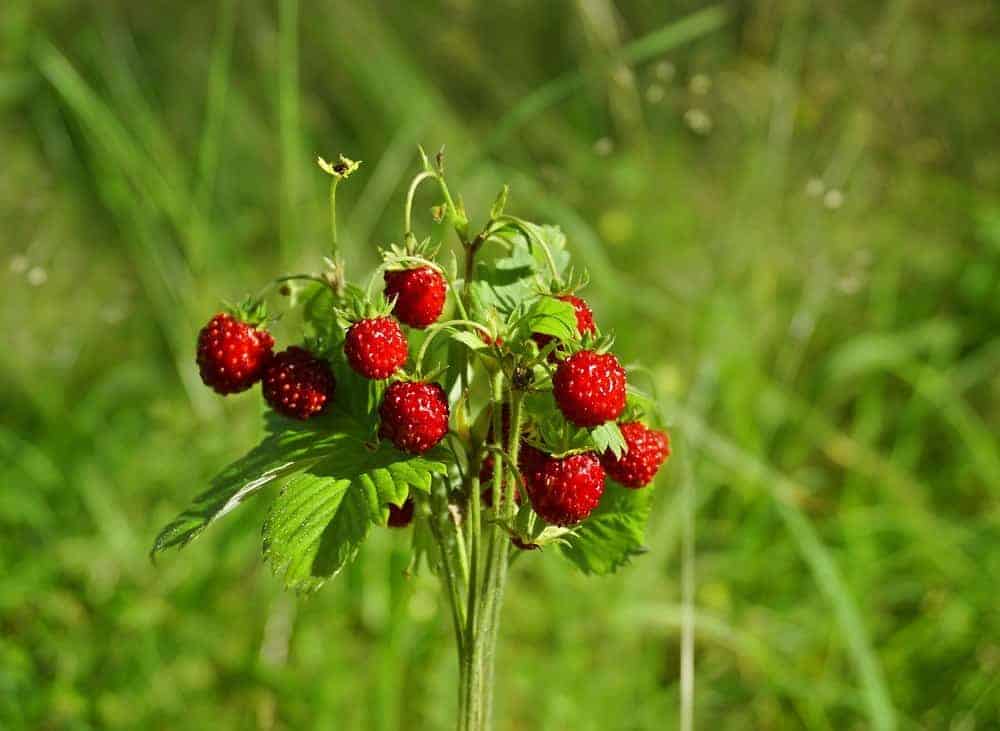
A fruit wine is only as good as the ingredients which began it. If you start this process with delicious, ripe strawberries, you will be rewarded with a full-bodied, fruity wine.
So where are the best strawberries to be found?
Well, that will very much depend on where you live. Strawberries are one of the most popular fruits in the world, and they produced en masse just about everywhere from Vietnam to Venezuela.
However, the best berries are always the ones which grow closest to your home – the ones which are native to your area, familiar to your taste buds, and don’t have far to travel.
When it comes to delicate fruits such as strawberries, you want to minimize the time between the field and the table – as soon as the strawberry is picked from its stem, it starts to lose its juiciness and its flavor.
If you are lucky enough to have your own strawberry patch, this will be easy for you. Alternatively, it is worth tracking down any nearby strawberry farms and asking if they operate any self-picking services, or if they sell directly from their farm shop.
If you are buying your strawberries from the market, make sure they are organic and check the country of origin.
If they have travelled more than 100 miles, it is likely that they have been treated with some sort of preservative to prevent them from rotting, and these preservatives could have an effect on the quality and taste of your wine.
The other option is to go foraging for wild strawberries. A strawberry wine recipe that includes wild berries is a truly rare treat!
Wild strawberries grow all over North America and Europe, and can be found by country pathways, in forest clearings, among hedges, by the roadside, on embankments and around the outskirts of wooded areas.
They like a lot of shade, but they may not bear fruit unless they are exposed to the sun for at least part of the day.
They are ready to pick from late spring, but if you are picking them wild you should start looking for your nearest supply as early as March.
The flowers should start blossoming around this time, giving you the best indication of where the best crops will be.
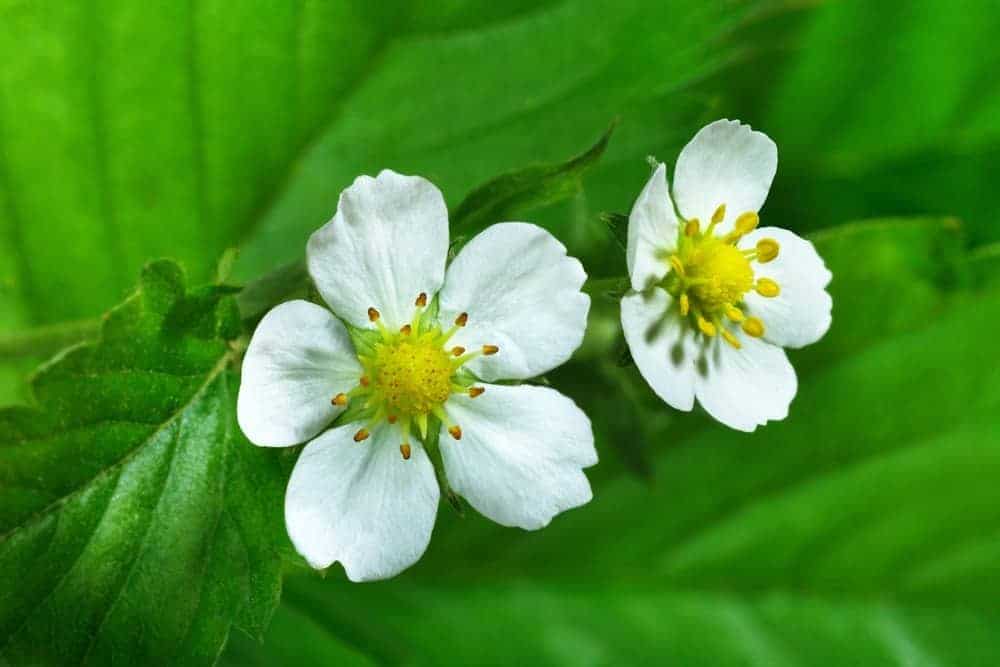
Wild strawberry flowers are tiny with white petals and a yellow center.
The fruit will start to appear 4-6 weeks after the blossoms have emerged, but they won’t be ready to pick until they are plump and red – not pink, not yellow, not green.
However, make sure you don’t wait too long before you pick them – strawberries are beloved by the entire insect and bird community, and they will gorge on the fruits the moment that they ripen.
Wild strawberries are susceptible to some horrible infestations and diseases, so make sure that you are picking whole, unbroken strawberries.
If you spot a tiny hole in the flesh, leave it be. For reasons which are too disgusting to go into on a wine blog.
I would also recommend that you take a large basket and a pair of scissors with you while foraging for wild strawberries. If you cut them at the stem (at least one inch from the fruit) they will preserve themselves for a few hours.
However, if you pick the fruit directly then leave them in the basket for a few hours while you finish your forage and travel home, you may find a little bit of mold starting to form when you go to wash them.
There’s nothing wrong with a tiny bit of mold, but when it spreads to the other strawberries it can prematurely start the fermentation process, which makes the rest of the wine-making process much more difficult.
A final word of advice: if you are determined to pick wild strawberries for your wine, make sure you give yourself plenty of time, and bring a few friends.
Wild strawberries are tiny, the size of raspberries rather than strawberries. In order to collect a full 5lbs (well, 6lbs to be safe) you will be picking strawberries all day long.
Having said that, they are brighter and tangier than any other type of strawberry, so if you want a truly unique and flavorsome wine its worth going the extra mile (literally) and using wild berries.
STEP TWO – Preparing your strawberries
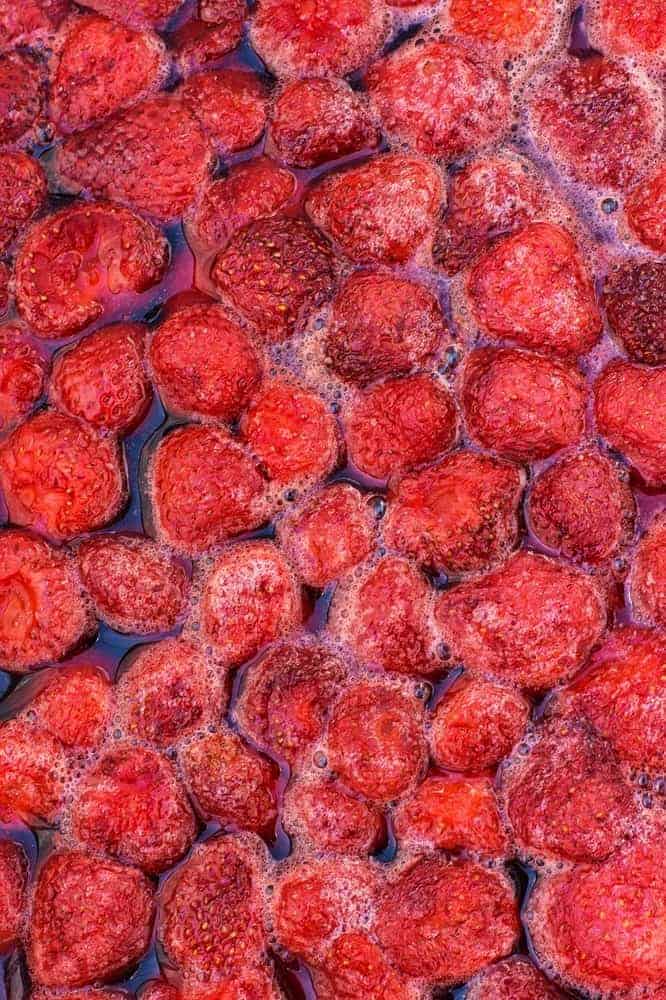
Before you start preparing your strawberries, boil up approx. one gallon of water in a large pot.
Allow it to cool slightly then stir in the sugar until it dissolves. You will be adding your strawberries straight in here once they’re ready, so keep them nearby.
If you are using fresh strawberries, go through them one by one, removing any visible dirt or insects on the flesh and discarding any which are under ripe, overripe, or damaged.
While you are doing this, remove the green head off each piece of fruit by twisting it between your finger and your thumb, or use a knife to trim the head.
Clean them thoroughly by submerging them in a basin of cold water for at least ten minutes, then skimming off any dirt that has risen to the surface. Then rinse them well and begin!
When it comes to strawberries, I think the less you do to them the better. I would just chop them in half so that you are releasing all that strawberry goodness inside. But you can just as easily use them whole.
Winemakers are divided on how to release the juices from your strawberries. Some say that you should put them straight into a straining bag, then place it in the fermentation bin and pour the sugar water over it.
The juices will slowly seep out and this will result in a much less cloudy wine, which means less racking in a few months’ time.
However, I think that you also lose a little of the flavor this way, so I prefer to just throw the strawberries directly into the sugar water then pour it all into the fermentation bin.
Leave your strawberry mix to cool overnight. The next morning, use a potato masher (sterilized, of course) to mash up the strawberries to a pulp – your fermentation bin will look as though its full of very watery strawberry jam at this stage.
Leave it in a cool, dark place for another 24 hours, and no longer. After a week or so, your strawberry mush will start to ferment organically, using wild yeasts. While this may sound like less hard work for you, it’s actually a really bad idea.
You are taking a gamble with wild yeasts – there’s a small chance that they will result in a perfectly brilliant strawberry wine, but it’s much more likely that they will act unpredictably, either spiking or dissolving the alcohol content and leaving you with an undrinkable vinegar.
If you go back to your strawberries and notice a thick froth bubbling away on the top of the mixture, my advice is to add a crumbled up campden tablet, give it a stir, leave it for 12 hours then move on to the next step. The campden tablet will help to sterilize the mixture and stop any early fermentation.
PRO TIP: If you have a hydrometer you can start taking a gravity reading of your wine now. If it’s too sweet, add more (filtered) water; and if it’s too dry, add more sugar.
STEP THREE – Fermentation time!
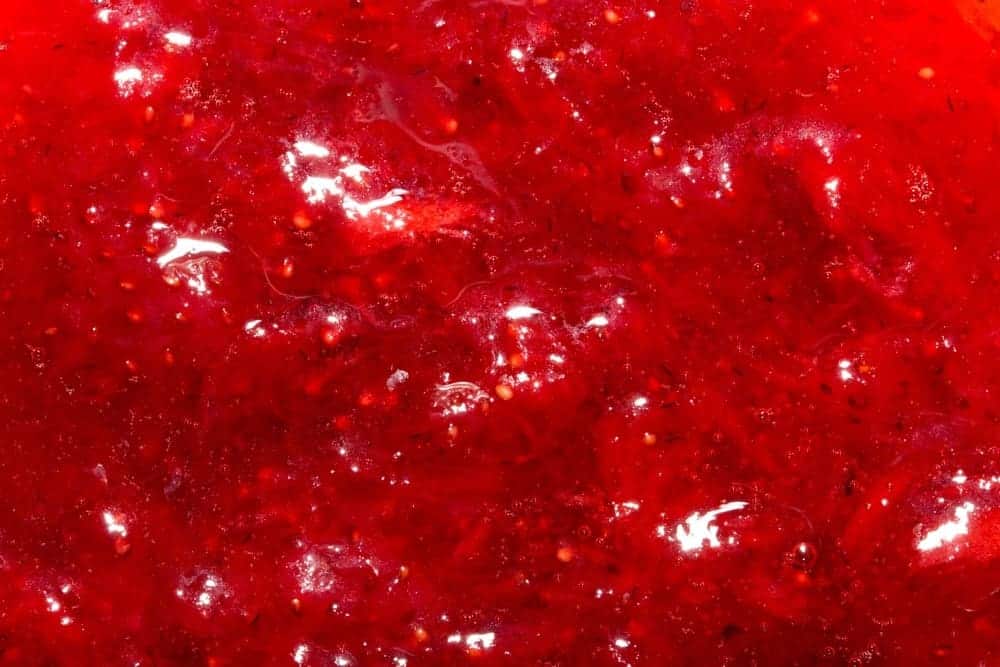
Now that your strawberries have released their juices, you can start to strain out the pulp.
Use your straining bad and pour the mix into a sterilized pot or food-grade basin, then clean and sterilize your fermentation bin so it is ready for use again almost immediately.
Squeeze your straining bag a little to release as much juice as possible, then discard the pulp. Some brave souls like to use this sugary pulp to make a jam (just add a little water and boil it up, then add a pinch of pectic enzyme and a sheet of gelatin, and cool before transferring into sterilized jam jars). I simply add it to the compost bin and use it to fertilize my strawberry patch for next year.
Pour your strawberry liquid back into the newly sterilized fermentation bin, then add the lemon juice (or citric acid), the yeast, the yeast nutrient and the tannin (if using). Cover it and leave it back in a cool, dark place and stir it twice a day for around 5-7 days.
Your mixture should start bubbling up nicely after a day or so, before tailing off around day five or six. At this point, you can skim off any foam on the top, and start thinking about step four!
STEP FOUR – The technical bit!
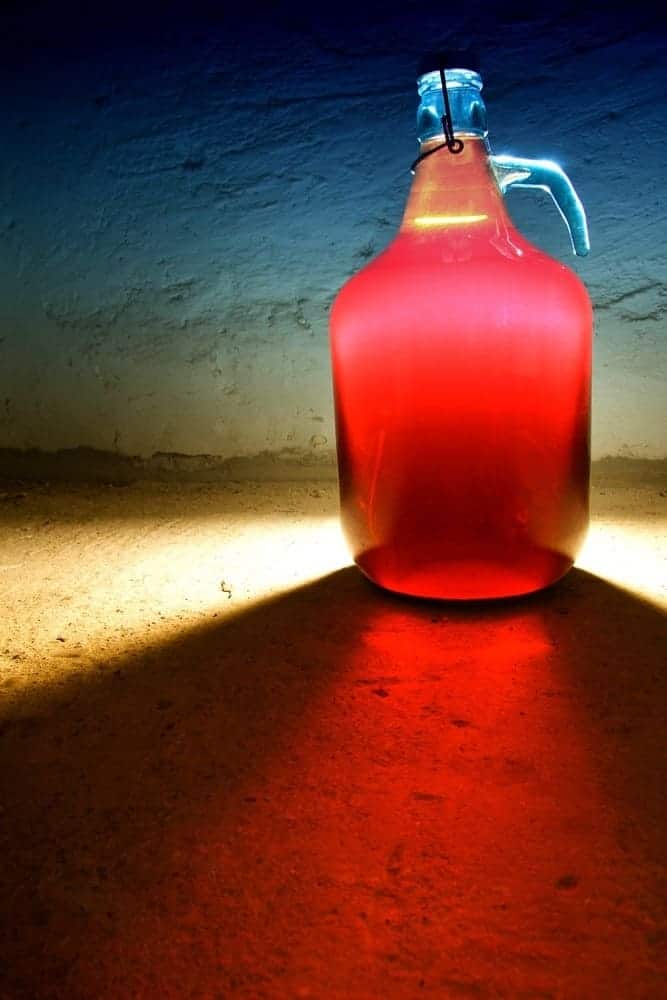
This is where our strawberry wine recipe turns into more of a science experiment!
Once the initial fermentation has slowed down, you can start moving the wine into your demijohn. First though you’ll need to strain it again.
Strawberry wine is more pulpy than most, so you are going to have to strain it a few times before its ready. You know what you’re doing now, so just make sure everything is sterilized, and get to work!
Now you need to dig out your demijohn and funnel. Oh, and put a towel down – if this stuff spills on wood or carpet it WILL stain.
Carefully, slowly pour the wine mix through the funnel into the demijohn. If it doesn’t quite reach the top, you can add some water and sugar (use a ratio of three parts filtered water to one part sugar or sugar syrup).
Then secure the bung and airlock, and put the demijohn in a cool, dark place for at least three weeks.
You will notice that it starts violently bubbling after a few days, and the airlock will be glugging away. This is all totally normal, so just enjoy the show!
After a couple of weeks, the bubbling will start to slow to a gentle fizzing. Keep an eye on it, and when there is a long gap between each bubble, you can start to move on to the next step.
STEP FIVE – Racking!
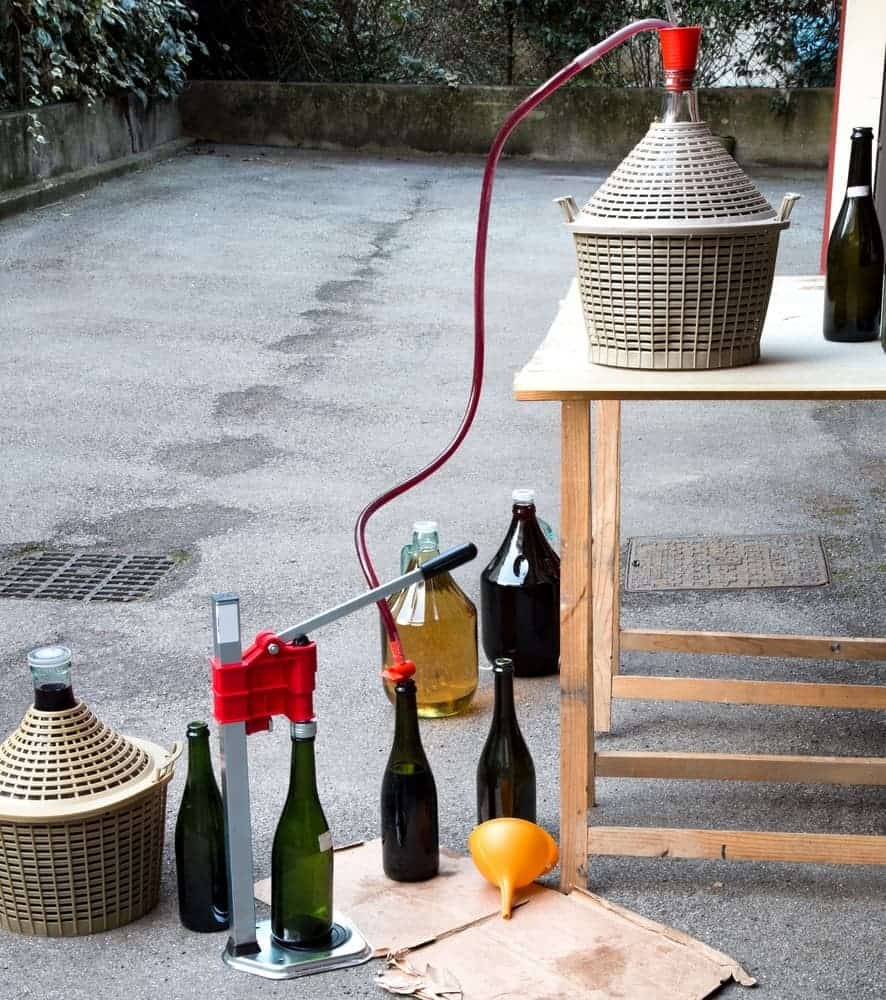
By now you will notice that there is a layer of dark pink sediment forming on the bottom of your demijohn.
No matter how well you strain your strawberry pulp, there will always be something left in the wine afterwards, so you will need to rack your wine to get rid of it.
First, place your demijohn on a flat countertop, and on the ground below it, position an empty, freshly sterilized demijohn.
Remove the airlock and bung, and lower the vinyl tubing around ¾ of the way down the bottle. Take the other end (the one that isn’t drowning in strawberry wine), and suck – hard – until you taste wine.
Then use that end of the tube to fill the empty demijohn with your wine, leaving behind the sediment at the bottom of the original bottle.
Be very careful not to disturb the strawberry sediment or accidentally suck it up through the tube and into the new demijohn.
It’s not the end of the world if this happens, but you will have to rack your wine an extra time if you want it to be clear.
When all the wine has been transferred, put the bung and airlock onto your new demijohn and put it back into storage.
Repeat this process after another three weeks. Then repeat once more, three weeks after that. You are the best judge when it comes to getting a clear wine – if your wine has a lot of sediment, you may need to rack it four or five times. If you’ve used pectic enzyme, you may only need to rack it twice.
Once it’s clear enough to resemble a good rose, you are ready to start thinking about bottling.
STEP SIX – Bottling up!
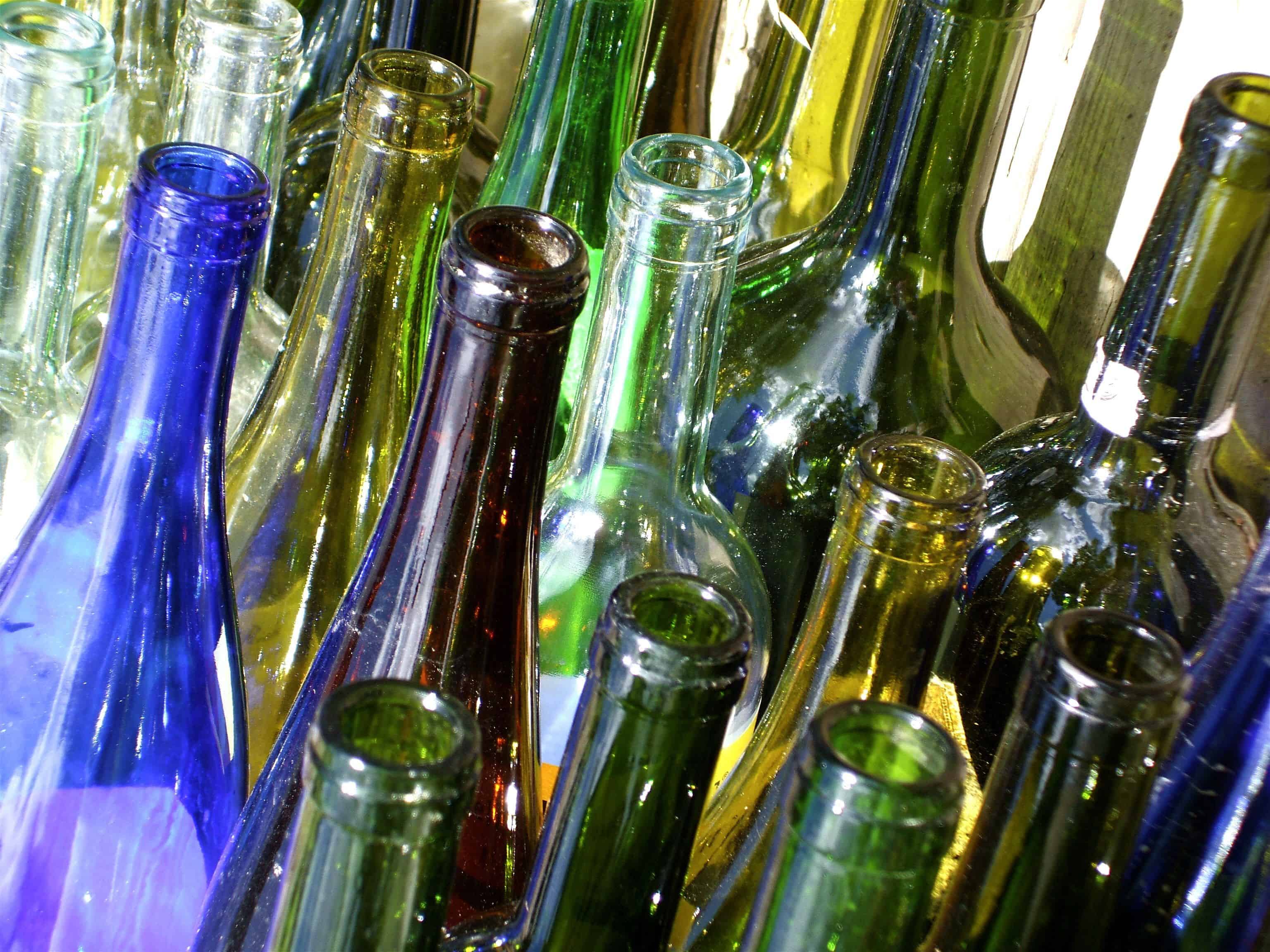
Finally, the time has come to bottle up your strawberry wine. You are one step closer to enjoying a large glass of strawberry wine made with your own two hands.
All you have to do is rack the wine one more time (to ensure that your wine is a pretty clear pink color) then line up your bottles, and use your siphon tube to move the wine one last time, from your demijohn into the bottles.
Cork and seal your bottles, and make a little label for each one so that you don’t forget what’s inside (not that you would). And that’s it!
Now all that’s left to do is wait for the wine to mature. For strawberry wine, this usually takes one year at least, although you can probably start drinking it from around six months onwards.
The longer the wine matures, the drier it will be, but bear in mind that strawberry wine will always be a little sweeter than most. Even after a year, it will taste more like a White Zinfandel than a crisp Provencal rose.
If you can’t wait a whole year to crack open a bottle, serve it as a dessert wine in a tiny sherry glass, so that your guests savor every last drop. Or make your very own version of a mojito, by combining strawberry wine, soda water, and fresh mint in a tall glass over ice.
Or why not make a summery sangria, with strawberry wine, white grape juice and sugar, plus lots of chopped up strawberries, apples, orange slices and ice.
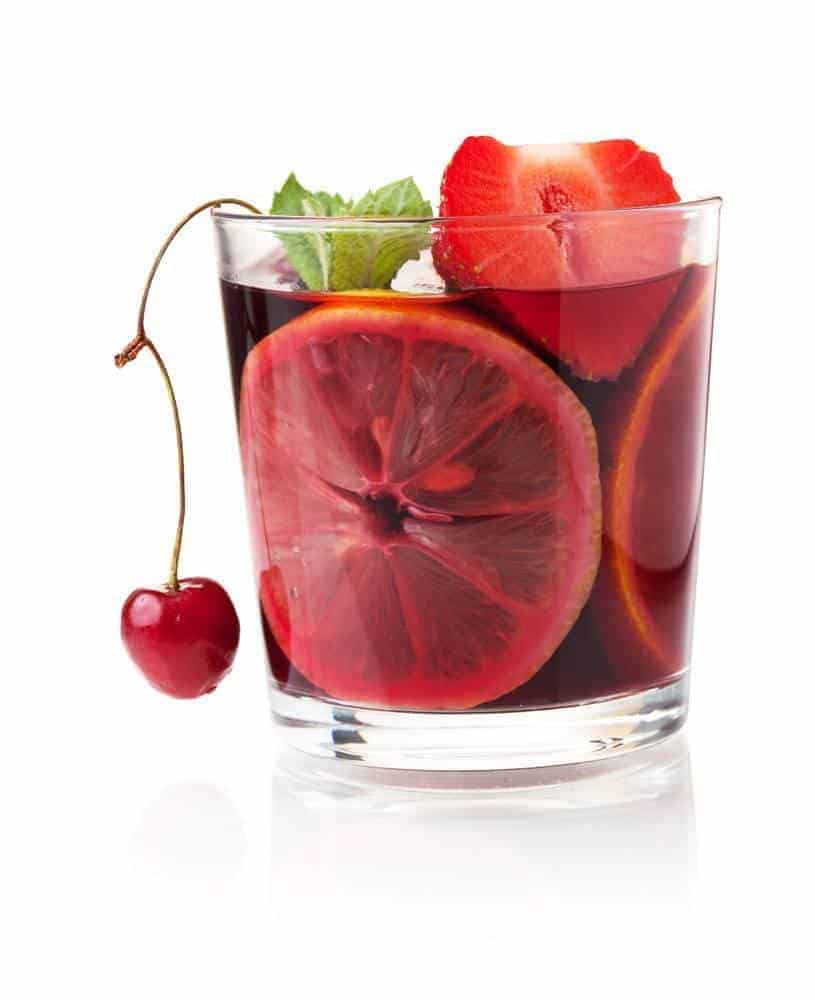
You can also make a show stopping strawberry sorbet out of this wine – the alcohol content means that it doesn’t freeze completely, but cools into a sweet strawberry slush instead.
If you’re ever in need of a quick and easy dessert, just pour a couple of glasses of this wine into a freezer-proof dish, and freeze it for an hour or two – break through the icy layer on top and serve in martini glasses with a sprig of mint or basil, and voila – a sophisticated, adults-only dessert at your fingertips.
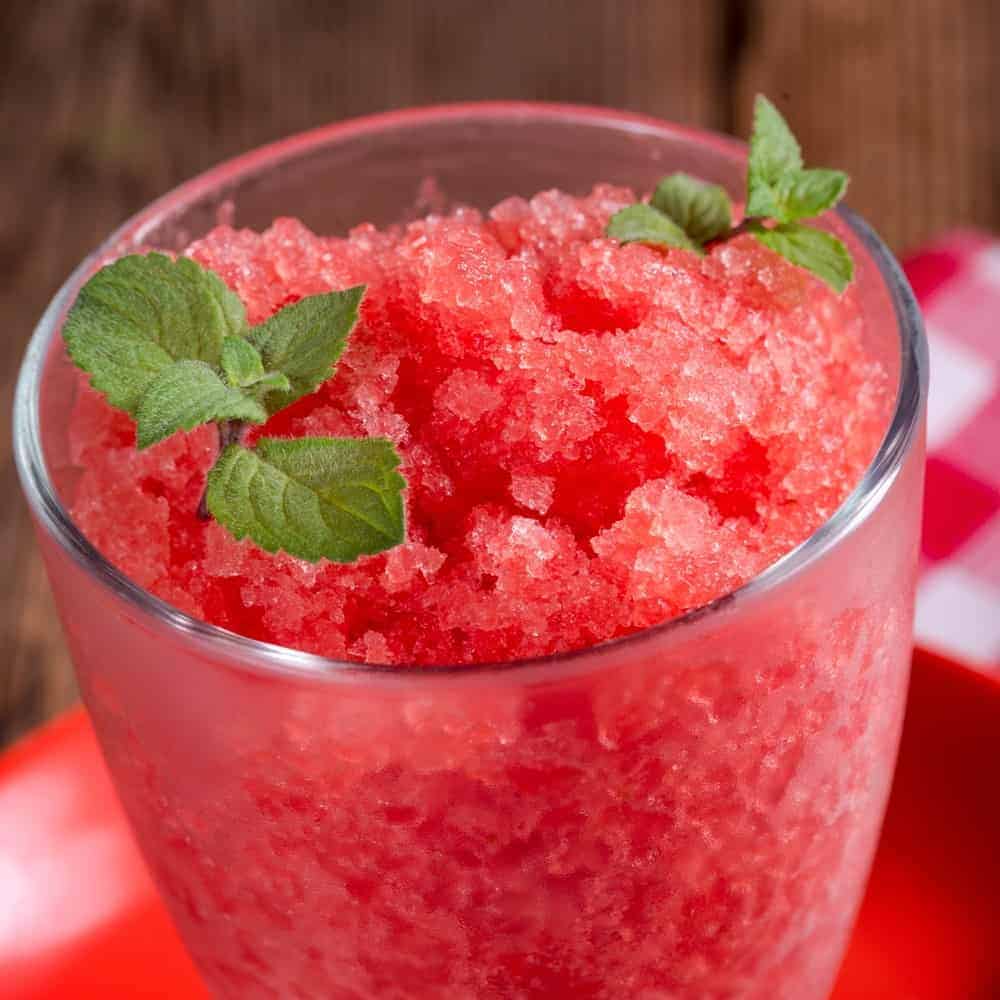
Let us know how you are enjoying your strawberry wine, and share your own recipes in the comment section below!
Recommended Article: Don't forget to check out our muscadine wine recipe after this!
Conclusion
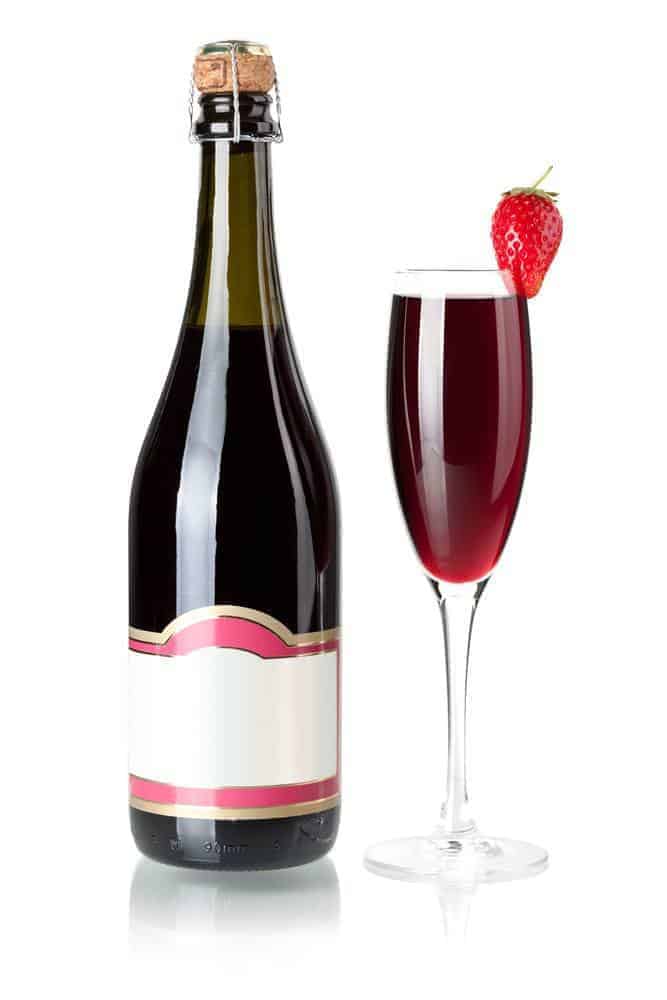
Strawberry wine never fails to raise a smile – maybe it’s the color, or maybe it’s the nostalgic flavor which conjures up memories of sweet cordials in the heat of summer, and fruity ice creams by the lake.
This is a definite crowd-pleaser, and one which every home wine maker should have in their arsenal.
If you enjoyed making this wine, you might also like to try some of our other fruit wine recipes. The more adventurous readers may even like to try their hand at combining two or more different flavors – I can tell you from firsthand experience that our strawberry wine and apple wine recipes are a match made in heaven.
You will end up with a blush wine rather than a full blown rose, but the taste is out of this world.
Let us know what you did with your strawberry wine, and how you will be drinking it this year.
Please leave any anecdotes and advice in the comments below, and feel free to share this article with your friends and family so that we can spread the joy of strawberry wine far and wide.

Hey,
Making wine at home is easy after read your Recipe.I will try to make it.
Thank you!
Thanks Lizapaul – let me know how it goes for you or if you have any questions!
It would be nice to have a receipt for a 5 gallon batch